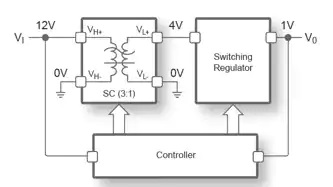Source : Mouser Electronics
Every part of an electronic design is like taking various building blocks and making them work together in harmony to accomplish the design goal. Electronic design engineers are always searching for further miniaturization of parts, increased functionality, and higher reliability.
DC-DC Converters
DC-DC converters are fundamental building blocks used in electronics power management circuits. They convert one direct current (DC) voltage to another DC that is either a greater (step-up, boost) or lower (step-down, buck) voltage. Murata has successfully introduced a lineup of buck regulators that has demonstrated an almost two-times reduction in footprint and a one-third reduction in height with significant improvements in power efficiency, transient performance, and electromagnetic interference (EMI). This improvement has been made by using a unique architecture called BK™ (Block). The BK™ is Murata’s innovative building block to smaller, higher efficiency DC-DC converter design. Let’s take a closer look at this creative breakthrough.
Buck Regulators: One-stage
Metal-oxide semiconductor field-effect transistors (MOSFETs) are commonly employed as electronic switches. Buck regulators often utilize internal power FETs. In the drive to reduce the size and simplify buck regulators, especially for low output currents (< 20A), many parts are offered with a controller and integrated FETs within one package. A controller with an integrated FET can compromise efficiency because, in specifying for a wide range of applications, these FETs’ voltage ratings can be much higher than those needed for a given application, resulting in increased switching losses. Also, the dimensioning of the FETs will almost certainly be sub-optimal for a specific duty cycle. This latter point can be a significant compromise, especially for low-duty cycle applications.
Packaging technology is deployed to reduce the size and squeeze every possible milliohm of parasitic losses from the powertrain to glean efficiency improvements. Integration of complete powertrains—control plus FETs, output inductor, and input/output filters—is impeded primarily by the physically large inductors that are still required.
2-Stage Buck Architectural Alternative
Murata’s BK™ power architecture resolves many of these issues. It allows switching frequencies to remain in the 1MHz to 2MHz range while reducing the amount of inductance required, plus improving overall power conversion efficiency.
Murata’s breakthrough employs a two-stage architecture comprising a charge pump, a switched-capacitor converter, with a switched-mode power supply. Murata’s proprietary charge pump design solves fundamental issues traditionally associated with charge pumps, namely low efficiency and high EMI.
The current source used in Murata’s system is, in effect, an inductor in a buck stage. This inductor is a close approximation to a current source and is used to absorb all of the charge redistribution losses typically made in the switch. Because this current source inductor can be in the output stage, the energy, rather than being lost, can be recycled as useful energy to the load. This recycled energy allows the series resistance of the charge pump switch (and associated parasitic impedances) to be made as small as possible because inrush current is no longer an issue and minimizes the charge redistribution losses in this part of the circuit. In terms of efficiency, Murata’s charge pump is 97 percent to 99 percent more efficient (Figure 1).

Figure 1. Two-stage buck converter combining a charge pump plus switching regulator (Source: Murata)
The charge pump itself is also two-phased, interleaved, and presents to the input almost 100 percent duty cycle. Compared with a traditional buck regulator, where the duty cycle might be only 10 percent, this makes a massive difference to the input current ripple and the amount of input filtering needed. In tests, Murata measured at least five times lower input current ripple than an equivalent single-stage buck (Figure 2)

Figure 2: Comparison of input current ripple for single-stage buck versus Murata two-stage. (Source: Murata)
Reduced EMI
Murata’s two-stage architecture breaks down the whole voltage transition into many small voltage steps executed across multiple input and output phases. Compared to single-stage buck designs, the net result is a much lower EMI signature for Murata’s architecture for conducted and radiated EMI. A major source of EMI in single-stage bucks is the inductor (V(t) = L * (di/dt)). Because Murata uses much less inductance in the system, much of the EMI source is naturally eliminated.
Product Example
Murata MY Series UltraBK™ 4A/6A DC-DC Converter Modules are miniature UltraBK, called Ultra Block. They are an ultra-thin, high-efficiency integrated power solution that combines a 4A or 6A DC-DC converter with components. These integrated modules provide up to 90 percent or 90.5 percent efficiency in a small, thin LGA package that measures 10.5mm x 9.0mm x 2.1mm. The easy-to-use module terminal design allows for a simple power layout and maximum efficiency by minimizing parasitic routing resistance. Other features include power good output, overcurrent, and over-temperature protection, remote on/off control, and output voltage sense.
Applications
Murata MY Series UltraBK 4A/6A DC-DC Converter Modules are well-suited for use in PCIe/server applications, field-programmable gate array (FPGA), and digital signal processing (DSP), datacom/telecom systems, distributed bus architectures (DBA), programmable logic, and mixed voltage systems. Select versions can also be used in I2C 6.0-compatible serial interfaces operating up to 1MHz.
Conclusion
You have seen how Murata demonstrated a unique and somewhat unintuitive two-stage architecture that uses many low-voltage FETs throughout the powertrain in a complex arrangement. This architecture achieves best-in-class efficiencies in much smaller footprints and profiles.
This two-stage buck is an architectural innovation using standard off-the-shelf FETs in a very mature CMOS semiconductor process. Because the inductor is no longer the dominant component in the bill of materials, power conversion shrinks from occupying typically 30 percent to 40 percent of a system’s circuit area to half of that, without compromising efficiency. Furthermore, because the inductor usually is one of the tallest components in a system, this architecture allows for thinner solutions, improving packing density, and enabling mobile products to be slimmer.
Don’t be a blockhead (Figure 3). The building blocks to smaller, higher efficiency DC-DC converter designs is Murata’s BK™ (Block) two-stage architecture. Look to Murata—a worldwide leader in the design and manufacture of ceramic passive electronic components, wireless connectivity modules, and power conversion technologies—for solutions when designing your next power management designs.
 Figure 3: Don’t be a blockhead; look to Murata for the building blocks to smaller, higher efficiency DC-DC converter design. (Source: Photobank gallery/Shutterstock.com)
Figure 3: Don’t be a blockhead; look to Murata for the building blocks to smaller, higher efficiency DC-DC converter design. (Source: Photobank gallery/Shutterstock.com)
To learn more, visit www.mouser.com












